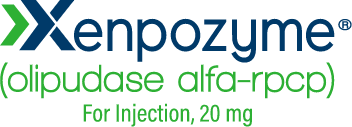XENPOZYME DOSING


- An initial dose escalation phase is necessary for XENPOZYME.
- The recommended starting dose is 0.1 mg/kg for adult patients and 0.03 mg/kg for pediatric patients (under age 18).
- Dose escalation takes at least 14 weeks for adults and at least 16 weeks for pediatric patients.
- In the clinical trial in pediatric patients, all but 1 patient completed the dose escalation up to the maintenance dose of 3 mg/kg within 22 weeks.
- Initial dose escalation should take place in a clinical setting.
- If doses are missed, re-escalation may be necessary.
- The maintenance phase of XENPOZYME can take place every 2 weeks, after the patient has successfully completed the dose escalation regimen.
- XENPOZYME target maintenance dose: 3 mg/kg
- Home administration under the supervision of a healthcare provider may be considered for patients who are receiving the maintenance dose and tolerating their infusions well.
- XENPOZYME provides an exogenous source of ASM. When infused, it metabolizes accumulated sphingomyelin into ceramide and phosphocholine components.1
- At the start of treatment with XENPOZYME, the rapid metabolism of accumulated sphingomyelin generates pro-inflammatory breakdown products, which may induce IARs and/or transient transaminase elevations.2
- The dose escalation regimen provides a gradual debulking of sphingomyelin and gradual release of ceramide, decreasing the inflammatory response.1,2
- Verify pregnancy status in females of reproductive potential.
- XENPOZYME dosage initiation or escalation, at any time during pregnancy, is not recommended.
- Advise female patients of reproductive potential to use effective contraception during treatment with XENPOZYME and for 14 days after the last dose if XENPOZYME is discontinued.
- Consider administering pretreatment medication.
- Antihistamines, antipyretics, and/or corticosteroids may be given prior to XENPOZYME administration to reduce the risk of IARs. However, IARs may still occur in patients after receiving pretreatment.
- Assess baseline transaminase (ALT and AST) levels in all patients within 1 month prior to treatment initiation.
XENPOZYME requires 2 dosing phases: dose escalation and maintenance1
Dose escalation phase
Maintenance phase
Why dose escalation is necessary

A dose escalation regimen may reduce the risk of IARs or transient transaminase elevations at treatment initiation.1
Steps to take prior to treatment initiation1
ALT=alanine aminotransferase; ASM=acid sphingomyelinase; AST=aspartate aminotransferase; IAR=infusion-associated reaction.
Learn more about XENPOZYME dosing and preparation in our step-by-step guide.
Accurately track and monitor your patients’ XENPOZYME infusions.
Personalized support for your patient is available with CareConnect Personalized Support Services
IMPORTANT SAFETY INFORMATION
|
WARNING: HYPERSENSITIVITY REACTIONS INCLUDING ANAPHYLAXIS Patients treated with XENPOZYME have experienced life-threatening hypersensitivity reactions, including anaphylaxis. Appropriate medical monitoring and support measures, including cardiopulmonary resuscitation equipment, should be readily available during XENPOZYME administration. If a severe hypersensitivity reaction (e.g., anaphylaxis) occurs, discontinue XENPOZYME immediately, and initiate appropriate medical treatment. In patients with severe hypersensitivity reactions, a desensitization procedure to XENPOZYME may be considered. |
WARNINGS AND PRECAUTIONS
Hypersensitivity Reactions Including Anaphylaxis
See Boxed WARNING. Prior to XENPOZYME administration, consider pretreating with antihistamines, antipyretics, and/or corticosteroids.
- If a severe hypersensitivity reaction occurs, discontinue XENPOZYME immediately and initiate appropriate medical treatment. Consider the risks and benefits of re-administering XENPOZYME following severe hypersensitivity reactions.
- If a mild or moderate hypersensitivity reaction occurs, consider temporarily holding the infusion, slowing the infusion rate, and/or reducing the XENPOZYME dose.
Infusion-Associated Reactions
Antihistamines, antipyretics, and/or corticosteroids may be given prior to XENPOZYME administration to reduce the risk of infusion-associated reactions (IARs). However, IARs may still occur in patients after receiving pretreatment.
- If severe IARs occur, discontinue XENPOZYME immediately and initiate appropriate medical treatment. Consider the risks and benefits of re-administering XENPOZYME following severe IARs.
- If a mild or moderate IAR occurs, the infusion rate may be slowed or temporarily withheld, and/or the XENPOZYME dosage may be reduced.
Acute phase reactions (APRs), acute inflammatory responses accompanied by elevations in inflammatory serum protein concentrations, have been observed. Most APRs occurred at 48 hours post infusion during the dose escalation period. APRs were managed similar to other IARs.
Elevated Transaminase Levels
XENPOZYME may be associated with elevated transaminases (ALT, AST, or both) within 24 to 48 hours after infusion. Levels generally returned to levels observed prior to the XENPOZYME infusion. To manage the risk of elevated transaminase levels, assess ALT and AST:
- within one month prior to initiation of XENPOZYME,
- within 72 hours prior to any infusion during dose escalation, which includes the first 3 mg/kg dose, or prior to the next scheduled XENPOZYME infusion upon resuming treatment following a missed dose.
Upon reaching the recommended maintenance dose, transaminase testing is recommended to be continued as part of routine clinical management of ASMD.
Risk of Fetal Malformations During Dosage Initiation or Escalation in Pregnancy
XENPOZYME dosage initiation or escalation, at any time during pregnancy, is not recommended as it may lead to elevated sphingomyelin metabolite levels that may increase the risk of fetal malformations. The decision to continue or discontinue XENPOZYME maintenance dosing in pregnancy should consider the female’s need for XENPOZYME, the potential drug-related risks to the fetus, and the potential adverse outcomes from untreated maternal ASMD disease.
Verify pregnancy status in females of reproductive potential prior to initiating XENPOZYME treatment. Advise females of reproductive potential to use effective contraception during XENPOZYME treatment and for 14 days after the last dose if XENPOZYME is discontinued.
ADVERSE REACTIONS
- Most frequently reported adverse drug reactions in adults (incidence ≥10%) were headache, cough, diarrhea, hypotension, and ocular hyperemia.
- Most frequently reported adverse drug reactions in pediatric patients (incidence ≥20%) were pyrexia, cough, diarrhea, rhinitis, abdominal pain, vomiting, headache, urticaria, nausea, rash, arthralgia, pruritus, fatigue, and pharyngitis.
INDICATION
XENPOZYME® (olipudase alfa-rpcp) is indicated for treatment of non–central nervous system manifestations of acid sphingomyelinase deficiency (ASMD) in adult and pediatric patients.
Please see full Prescribing Information for complete details, including Boxed WARNING.
References: 1. XENPOZYME. Prescribing Information. 2. Wasserstein MP, Jones SA, Soran H, et al. Successful within-patient dose escalation of olipudase alfa in sphingomyelinase deficiency. Mol Genet Metab. 2015;116(1-2):88-97.
IMPORTANT SAFETY INFORMATION
|
WARNING: HYPERSENSITIVITY REACTIONS INCLUDING ANAPHYLAXIS Patients treated with XENPOZYME have experienced life-threatening hypersensitivity reactions, including anaphylaxis. Appropriate medical monitoring and support measures, including cardiopulmonary resuscitation equipment, should be readily available during XENPOZYME administration. If a severe hypersensitivity reaction (e.g., anaphylaxis) occurs, discontinue XENPOZYME immediately, and initiate appropriate medical treatment. In patients with severe hypersensitivity reactions, a desensitization procedure to XENPOZYME may be considered. |
WARNINGS AND PRECAUTIONS
Hypersensitivity Reactions Including Anaphylaxis
See Boxed WARNING. Prior to XENPOZYME administration, consider pretreating with antihistamines, antipyretics, and/or corticosteroids.
- If a severe hypersensitivity reaction occurs, discontinue XENPOZYME immediately and initiate appropriate medical treatment. Consider the risks and benefits of re-administering XENPOZYME following severe hypersensitivity reactions.
- If a mild or moderate hypersensitivity reaction occurs, consider temporarily holding the infusion, slowing the infusion rate, and/or reducing the XENPOZYME dose.
Infusion-Associated Reactions
Antihistamines, antipyretics, and/or corticosteroids may be given prior to XENPOZYME administration to reduce the risk of infusion-associated reactions (IARs). However, IARs may still occur in patients after receiving pretreatment.
- If severe IARs occur, discontinue XENPOZYME immediately and initiate appropriate medical treatment. Consider the risks and benefits of re-administering XENPOZYME following severe IARs.
- If a mild or moderate IAR occurs, the infusion rate may be slowed or temporarily withheld, and/or the XENPOZYME dosage may be reduced.
Acute phase reactions (APRs), acute inflammatory responses accompanied by elevations in inflammatory serum protein concentrations, have been observed. Most APRs occurred at 48 hours post infusion during the dose escalation period. APRs were managed similar to other IARs.
Elevated Transaminase Levels
XENPOZYME may be associated with elevated transaminases (ALT, AST, or both) within 24 to 48 hours after infusion. Levels generally returned to levels observed prior to the XENPOZYME infusion. To manage the risk of elevated transaminase levels, assess ALT and AST:
- within one month prior to initiation of XENPOZYME,
- within 72 hours prior to any infusion during dose escalation, which includes the first 3 mg/kg dose, or prior to the next scheduled XENPOZYME infusion upon resuming treatment following a missed dose.
Upon reaching the recommended maintenance dose, transaminase testing is recommended to be continued as part of routine clinical management of ASMD.
Risk of Fetal Malformations During Dosage Initiation or Escalation in Pregnancy
XENPOZYME dosage initiation or escalation, at any time during pregnancy, is not recommended as it may lead to elevated sphingomyelin metabolite levels that may increase the risk of fetal malformations. The decision to continue or discontinue XENPOZYME maintenance dosing in pregnancy should consider the female’s need for XENPOZYME, the potential drug-related risks to the fetus, and the potential adverse outcomes from untreated maternal ASMD disease.
Verify pregnancy status in females of reproductive potential prior to initiating XENPOZYME treatment. Advise females of reproductive potential to use effective contraception during XENPOZYME treatment and for 14 days after the last dose if XENPOZYME is discontinued.
ADVERSE REACTIONS
- Most frequently reported adverse drug reactions in adults (incidence ≥10%) were headache, cough, diarrhea, hypotension, and ocular hyperemia.
- Most frequently reported adverse drug reactions in pediatric patients (incidence ≥20%) were pyrexia, cough, diarrhea, rhinitis, abdominal pain, vomiting, headache, urticaria, nausea, rash, arthralgia, pruritus, fatigue, and pharyngitis.
INDICATION
XENPOZYME® (olipudase alfa-rpcp) is indicated for treatment of non–central nervous system manifestations of acid sphingomyelinase deficiency (ASMD) in adult and pediatric patients.
Please see full Prescribing Information for complete details, including Boxed WARNING.
References: 1. XENPOZYME. Prescribing Information. 2. Wasserstein MP, Jones SA, Soran H, et al. Successful within-patient dose escalation of olipudase alfa in sphingomyelinase deficiency. Mol Genet Metab. 2015;116(1-2):88-97.

